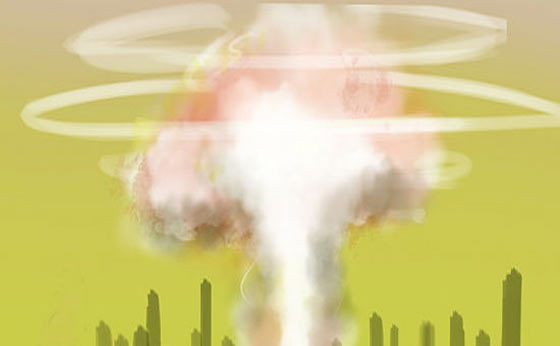Preparations And Survival For Nuclear War
The immediate psychological effects of a thermonuclear explosion – a surface burst of a nuclear weapon (or weapons) that suck millions of tons of pulverized and radioactive earth into the air – will be outright terror.
Stunned terror, confusion and panic – primarily because it will be an event that is so entirely outside the realm of normal thinking – it will ‘not compute’.
Those who grew up during the height of the cold war with the USSR have a better understanding about the threat of nuclear war. They prepared and they drilled for nuclear war. It was part of their real world and was within the real realm of possibilities. For those born after the cold war, the threat of thermonuclear war is simply not a part of the thought process.
A nuclear attack will be completely and entirely unexpected by nearly everyone. Why? Because most everyone suffers from normalcy bias and most everyone believes that because nuclear war has never happened, it never will.
The problem with that thinking is the assumption that the “powers-that-be” and nuclear powers “heads of state” are stable, sane, logical minded, and follow the doctrine of MAD (Mutually Assured Destruction). Many of us on the other hand also know that there are present day ‘questionable’ leaders and those in positions of world power and influence who may not necessarily place the same value on human life as you or I.
Suddenly, a brilliant and blinding flash of light…
Some people will think the end of the world is upon them following the blinding flash of light – seen many 10’s of miles from ground zero. The billowing red and orange fireball of boiling fire, towering into the sky, will trigger panic.
There will be no way to know at first if there are more to come, or if other cities have already been blasted. Chances are, there will be another wave.
The terror will paralyze most, who will do nothing at all due to shock and terror. There will even be those who will suffer heart-attacks from the fear and panic of the horrific event. Chaos.
The thing is, other than ground zero and the immediate vicinity within nuclear fallout, a nuclear attack is likely survivable, so long as you are not located within the blast zone of instant death. Certainly your life (everyone’s life) will be changed forever, but you will stand a chance to survive. Nuclear survival will involve many things and it will entail implementing a survival plan – up to and including a way of life which will give you a fighting chance to make it in a post modern world which may have been shredded and hurled into chaos.
Potassium Iodide Tablets, 130 mg (14 Tablets)
Related article: iOSAT™ Tablets For Your Nuclear Survival Kit
Geiger Counter Nuclear Radiation Detector
What will you do immediately after the nuclear explosion?
The very first warning sign may be the blast itself.
Note: Under no circumstances should you look directly at the fireball, or suffer probable temporary (or permanent) blindness.
Your greatest immediate need will be shelter from fallout. Seek shelter immediately. If you are several miles out and survived the initial blast, you may have 30 seconds until the shock wave.
Even at 5 miles out, you may suffer third degree thermal-burns, depending on the nuclear blast yield. At 20 miles the heat may still burn your skin.
The wind from the vicinity shock wave will peak at around 600 mph and will level anything or anybody caught in the open.
The best bet for survival within blast zones and their perimeters will be underground, with dirt/earth between you and the fallout/radiation.
Related article: Nuclear Radiation Shielding Protection
If the detonation was a surface blast, large amounts of nuclear fallout will occur as the blast mixes with earth (dirt/debris) and rises up into the atmosphere. The dust and debris kicked into the atmosphere will then “rain down”, bringing with it dangerous amounts of radiation. The fallout may drop from the atmosphere as contaminated black soot known as “black rain,” which is very fatal and may be of extreme temperature. Fallout will contaminate anything it touches.
Generally speaking, plan on staying in your shelter for a minimum of 200 hours (8-9 days) if you are anywhere withing the vicinity of the nuclear blast. Under no circumstances leave the shelter in the first forty-eight hours.
A primary aspect to survival will be to keep any radioactive dust/debris/fallout from contacting your body – or breathing it in, if you are within range of the fallout cloud.
After the initial shelter-in-place period, you will need to leave the area completely. The ground will be covered with radioactive dust/debris. Leave the area when “the dust has settled” so to speak. Then enact your bug-out plan.
If you are outside the range of nuclear fallout, then your primary concerns will be any immediate follow-on attack versus the proximity to where you are located. If that is not an issue, then you will be entering the phase of SHTF, where life as you know will be changed forever. Your survival will now depend on your preparations for a major collapse, and all that goes along with it…
The psychological preparations for nuclear war involve the acceptance that it could actually happen – shedding your normalcy bias, and then the planning for such an event (which will overlap with other preparations if you are a preparedness-minded person).
Note: After nuclear detonation(s) there will likely be financial meltdown. This in and of itself will bring chaos to the world as we know it.
The scope here is not to tell you how to survive nuclear war, but to get you to start thinking about it – the first step to taking action…

